Jean Claudius/Clodius Tempère, 1847 - 1926
(Johannes Albert Tempère)
“S. Louis”: 1883 - ca. 1901
Tempère and Petit, 1887 - 1893
Tempère and Peragallo, 1889 - ca. 1915
Tempère and Dutertre, 1892 - 1893
by Brian Stevenson
last updated December, 2017
J. Tempère is well-known to microscope enthusiasts because of the high-quality microscope slides of diatoms that he sold under the pseudonym “S. Louis”, or under his own name (Figures 1 and 2). He also produced slides with many other types of objects (Figures 1 and 2). “S. Louis” slides and unmounted specimens were distributed in England by William West (1848-1914) of Branford, Yorkshire, between 1883 and the turn of the twentieth century. West was also a keen microscopist, and shared many scientific interests with Tempère. Considering the longevity of this partnership, the two men probably had a comfortable relationship.
Tempère also produced two substantial, collaborative series of diatom slides: Diatomées de France, a 400 slide series that was prepared between 1887 and 1893 in conjunction with Paul Charles Michel Petit (1834-1913), and continued until 1900 in collaboration with Hippolyte Peragallo (1851-1921); and Diatomées de Monde Entier, begun in 1889 in conjunction with Peragallo. The 1915 edition of Diatomées de Monde Entier contained 1000 slides. A third series, of algae, entitled Algues de France, was issued between 1889 and 1892, in collaboration with Lucien Dupray (18??-1902). Yet another series of slides, focusing on fungi, was called Champignons de France and consisted of 250 microscope slides in 10 sets, and was produced between 1892 and 1893 in partnership with E. Dutertre.
Tempère also published two journals, La Diatomiste, between 1890 and 1896, and Le Micrographe Préparateur, between 1893 and 1906.
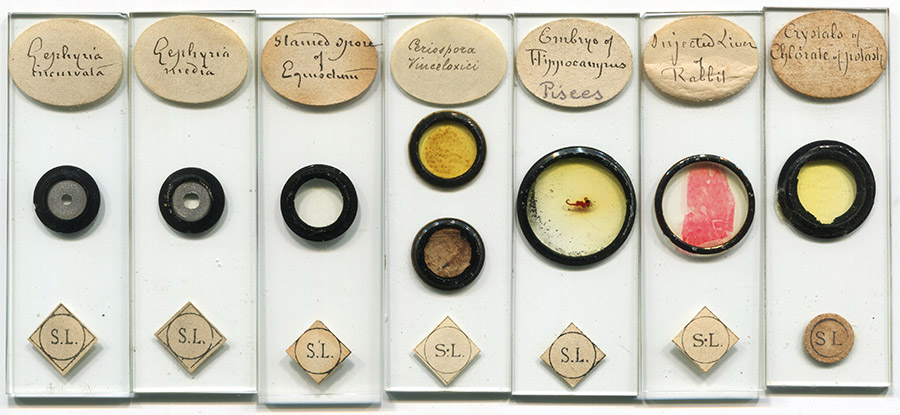
Figure 1.
A selection of slides prepared by J. Tempère and sold by W. West in England under the name “S. Louis” (“S.L.”). Note that the labels are written in English. This grouping includes mounts of selected diatoms, stained spores of Equisetum (horsetail), Cercospora vinceloxici (a leaf-blight fungus), embryo of a seahorse (Hippocampus), injected liver of a rabbit, and crystals of chlorate of potash (potassium chlorate).
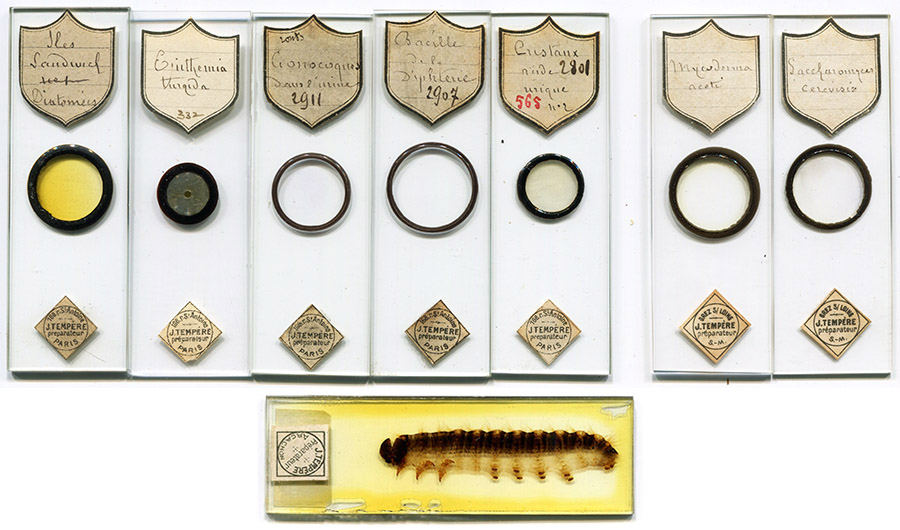
Figure 2.
Microscope slides by Tempère that were sold under his own name. The specimen labels are written in French, suggesting that these were produced for sale in his home country, although Tempère is known to have advertised such slides in England. Top row: The left five bear his address of 168 Rue Saint Antoine, Paris, dating them between 1884 and 1901. The two on the right have the address of Grez-sur-Loing, dating them between 1902 and 1914.
Bottom row: A slide with his post-1914 address in Arcachon.
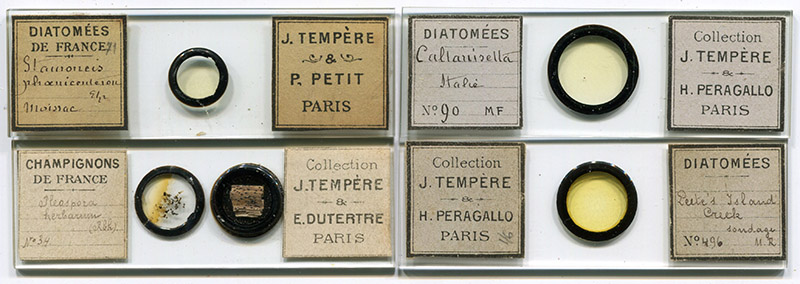
Figure 3.
Microscope slides prepared by Tempère in partnerships with Paul Petit, Hippolyte Peragallo, and E. Dutertre. The Tempère and Petit slide was made between 1887 and 1893. The Tempère and Dutertre slide was made between 1892 and 1893. The Tempère and Peragallo slides were made between 1889 and approximately 1914.
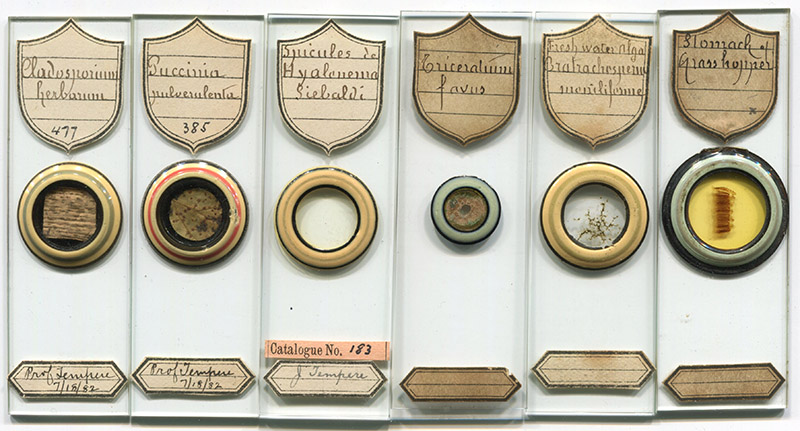
Figure 4.
The left two slides were marked as having been received from Professor Tempère in July, 1882. At that time, Tempère was a teacher at Storrington School, Sussex, England. The third slide from the left came from the same collection, and is marked “J. Tempère”. Therefore, those three slides, and presumably the other three, date from Tempère’s time when he lived in England and exchanged slides on an amateur basis (ca. 1877 - 1883). The leftmost three slides were previously in the collection of American microscopist William C. Stevenson, Jr. (1848-1919), an indication of how broadly Tempère’s slides were exchanged.
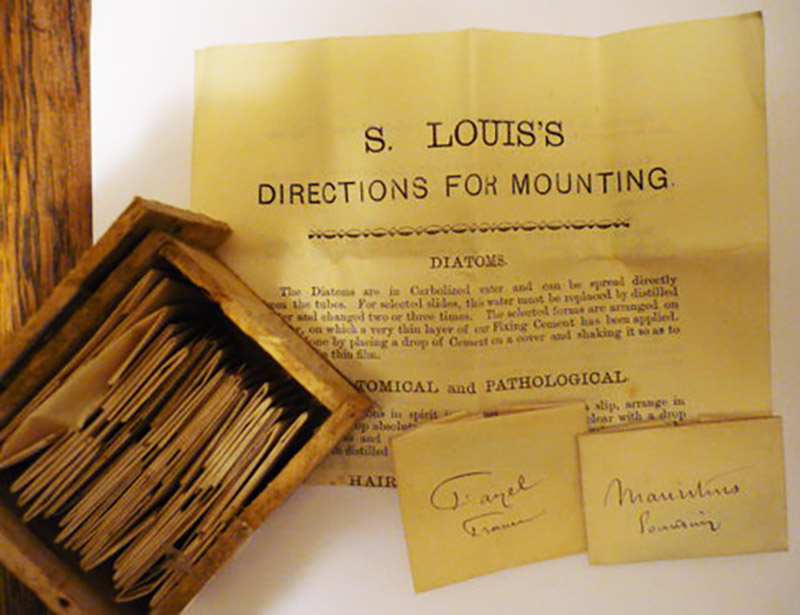
Figure 5.
In addition to prepared slides, Tempère and West sold cleaned, unmounted specimens for microscopists to mount for themselves. Adapted for nonprofit, educational purposes from an internet auction site.
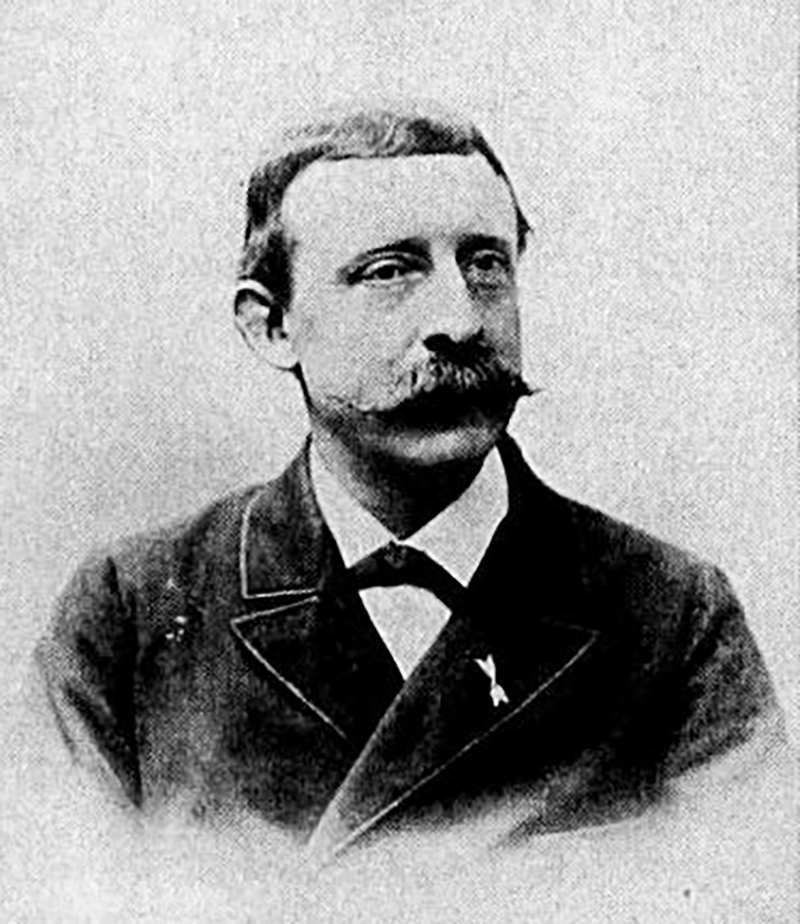
Figure 6.
J. Tempère, in middle life. Adapted for nonprofit, educational purposes from Girodet, 1999.
Tempère was known by two names, Jean Claudius/Clodius and Johannes Albert. His marriage record bears the name “Jean Claudius”. He is known to botanists as “Johannes Albert”. These might be various combinations of his full name. Most of his microscopical works used only his first initial, “J”. It is not known why he went by those different names, nor why he chose the nom-de-balsam “S. Louis” for his early sales in England.
J. Tempère was born on June 22, 1847, in Paris. His 1897 marriage record gives his parents’ names as Louis Fernand and Rose Rhode Tempère. The father was a textile merchant.
Tempère moved from Paris to England at the end of the Franco-Prussian War (July, 1870 - May, 1871). He reportedly joined his brother in London, who was also a textile merchant.
Cloth-selling was evidently not an agreeable profession for Tempère, so he instead taught French language in several cities around England. Some of his movements can be tracked by the exchange advertisements he posted in Hardwicke’s Science-Gossip (Figures 9 and 10). In March, 1877, he was at 23 Croucy Street, Colchester, Essex. By October, 1877, he was at 10 Heald Place, Rusholme, Manchester, and one month later he was at 12 Cecil Street, Moss Side, Rusholme, Manchester. He was still at Cecil Street in April, 1878, but moved by June, 1878 to 249 Moss Lane East, Manchester. Exchange offers from Moss Lane ceased in May, 1880, then restarted from Sussex in April, 1881. Tempère was then a French teacher at the Storrington School, Sussex. While at Storrington, Tempère co-wrote a textbook on French grammar with Henri Lallemand, published in 1883.
Tempère’s initial scientific interest appears to have been botany. He joined the Société de Botanique in 1870, prior to his move to England. Several of his English botanical collections are preserved in university herbaria (Figures 7 and 8). His earliest known exchange offers dealt with plant specimens (Figure 9). His future English business partner, William West, was also a botany enthusiast, and this common interest may have initially drawn the two men together.
Tempère is first known to have offered slides for exchange in 1879 (Figure 10). These were botanical preparations, although he sought to acquire diatoms, algae, zoophytes, and desmids. Through the years, his exchange advertisements offered a variety of slides in exchange for either raw material or prepared slides (Figure 10). At one point in 1881, he wrote of having “several hundred objects” available for trade. Amassing such an inventory would have honed his slide-making skills to a professional level.
Around May, 1883, Tempère and West began advertising diatom preparations by “S. Louis”, with West as the distributor (Figure 11). These initial offerings were not mounted slides, but were sold in “series of 12 tubes at 3s. per series”. Six series of diatoms were initially available, which rapidly expanded to include many other objects. They also offered “S. Louis’s Fixing Cement” and colored varnishes, preparing slides. Tempère moved home to Paris around the beginning of 1884, where he continued his microscopic and scientific pursuits, while also teaching English language.
The Journal of Microscopy and Natural Science reviewed S. Louis’ preparations in 1884, “Mr. Wm. West, of Bradford, has favoured us with a large selection of his objects, prepared for microscopical mounting, consisting of Diatoms, Spicules, Animal Hairs, Palates, Anatomical Sections Injected and Stained, Vegetable Sections Double Stained, and Miscellaneous, both Botanical and Non-Botanical. These objects are prepared by S. Louis, of Paris. At present we have had time to mount but a few of the above. We think they are all well prepared. The quantity is abundant, and in many cases quite sufficient for a number of slides”. A few months later, the magazine again wrote, “We have mounted a great number of the specimens prepared by Mons. S. Louis (France), and sold by Mr. Wm. West, of Bradford, and find them well prepared, abundantly supplied, and that' they make very excellent Slides. Each series is supplied in a neat wood box, the Diatoms, Algae, and many other objects, being in separate glass tubes. Directions for mounting will be found in each box”. An advertisement from an 1884 issue of that journal is shown in Figure 12.
The Diatomées de France series was begun in 1887, initially as a partnership with Paul Petit, who was replaced by Hippolyte Peragallo in 1893. This series reportedly reached a total of 400 different slides.
The initial slides of the Diatomées de Monde Entier series were issued in 1889, also in partnership with Peragallo.
According to records of the British Museum, Tempère began selling slides with his own name attached in 1888. They note diatom preparations, but a wide variety of Tempère-labeled slides are known to have been issued from his addresses in Paris, Grez-sur-Loing (in Seine-et-Marne), and Arcachon (in Gironde) (see Figures 2 and 13). Although the specimen descriptions on such slides are written in French, Tempère advertised them in England. Figure 13 shows a section of an advertisement page from an 1889 Hardwicke’s Science-Gossip, with side-by-side ads from S. Louis and J. Tempère.
Tempère published books and journals in addition to the bound lists that accompanied his slide series. In 1889, he wrote Diatomées Fossiles du Japon, in collaboration with Jacques Brun (1826-1908). Two journals, La Diatomiste and Le Micrographe Préparateur, were begun in 1890 and 1893, respectively.
A long-standing interest in microfungi led to the 1892 series Champignons de France, in partnership with E. Dutertre.
Tempère married Scholastique Porchon on August 8, 1897, when he was 50 years old. The couple had two children, Gaston (1900-1985) and Violette (born 1902). Gaston became a noted professor of botany and entomology.
The Tempère family moved to Grez-sur-Loing, in Siene et Marne, in 1902. At the start of World War I, in 1914, they moved west to Arcachon, near Bordeaux. Surviving microscope slides indicate that Tempère continued to produce slides through the time in Arcachon. He died there after a brief illness, at the age of 79, on February 12, 1926.
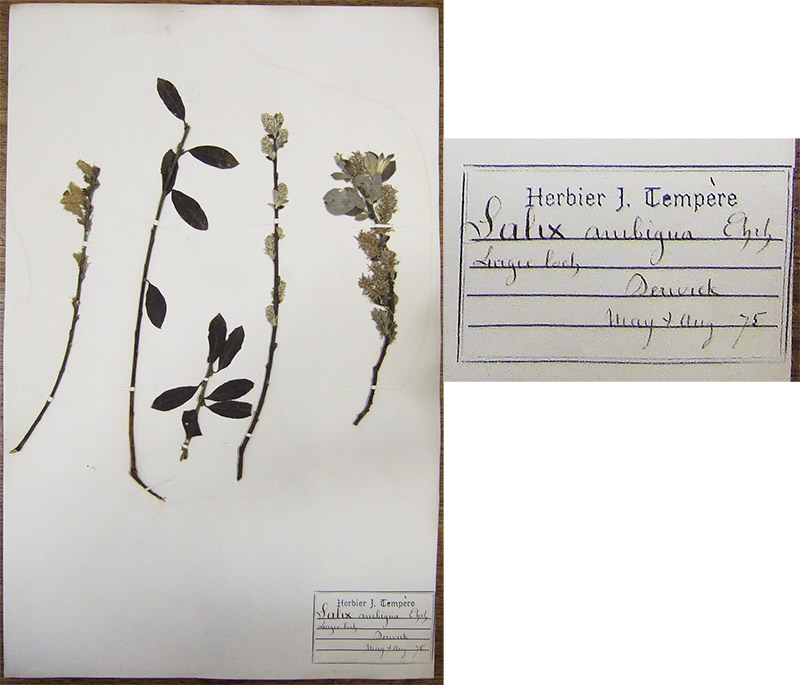
Figure 7.
Specimens of Salix ambigua (black willow), collected by J. Tempère during May-August, 1875 from Lurgie Loch, Berwickshire. Tempère’s label bears his characteristic handwriting. Adapted for nonprofit, educational purposes from the herbaria@home web site, http://herbariaunited.org/specimen/236870/?image.
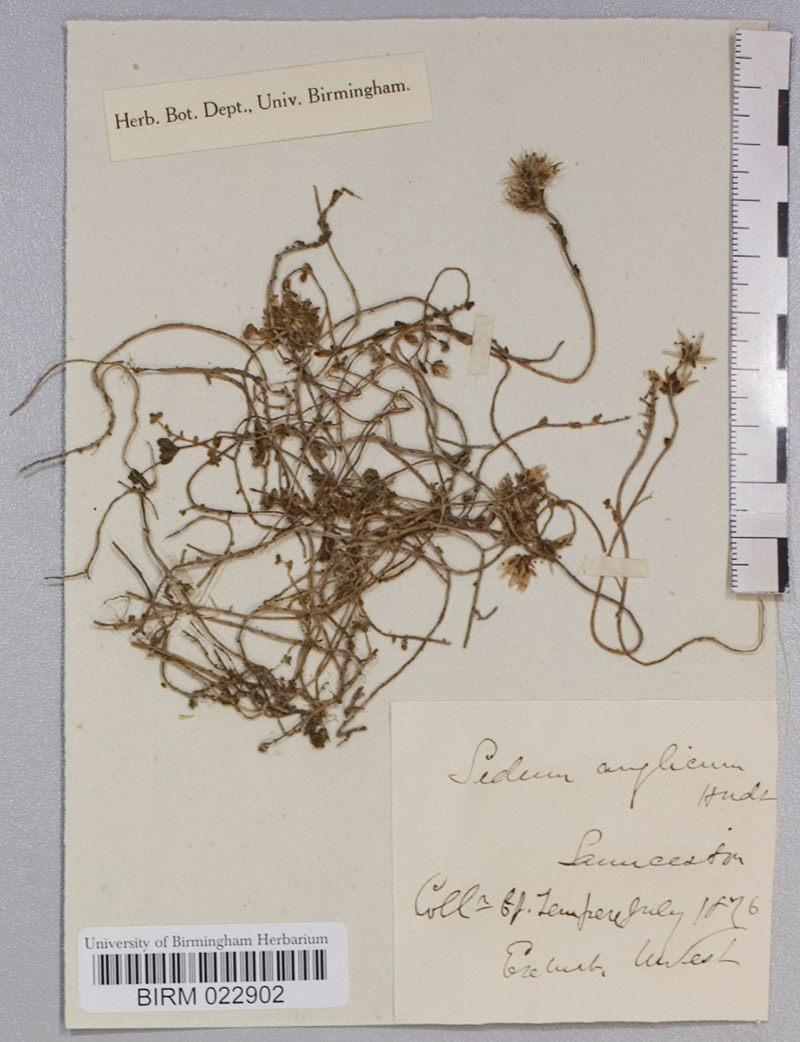
Figure 8.
Specimens of Sedum anglicum (English stonecrop), collected by J.C. Tempère in July, 1876 from Launceston, Cornwall. The label indicates that it was acquired from Tempère by William West. Adapted for nonprofit, educational purposes from the herbaria@home web site, http://herbariaunited.org/specimen/280719/?image.
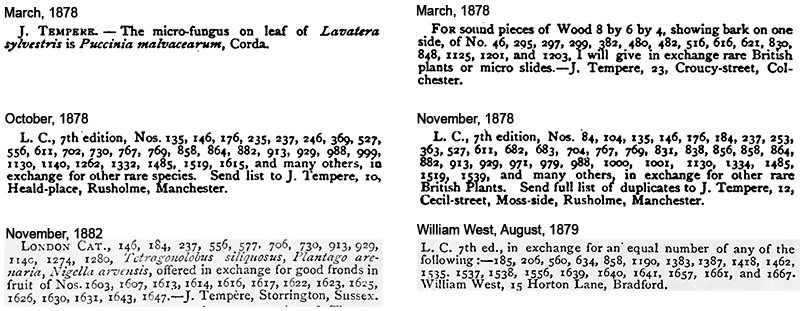
Figure 9.
1878 response to a query by J.C. Tempère, and several of his exchange offers, from “Hardwicke’s Science-Gossip” These are the earliest identified publications from Tempère. The exchange offers are requests for specimens of woods and other botanical items (“L.C.” refers to the London Catalogue of British Plants, Seventh Edition, published in 1874). They also indicate his movements from Colchester to Manchester between March and October, 1878, a change of address in Manchester during October, 1878, and his ca. 1881 move to Storrington, Sussex. A similar exchange offer from William West is also shown. Exchanges of botanical specimens may have brought Tempère and West together, leading to their long-standing partnership.
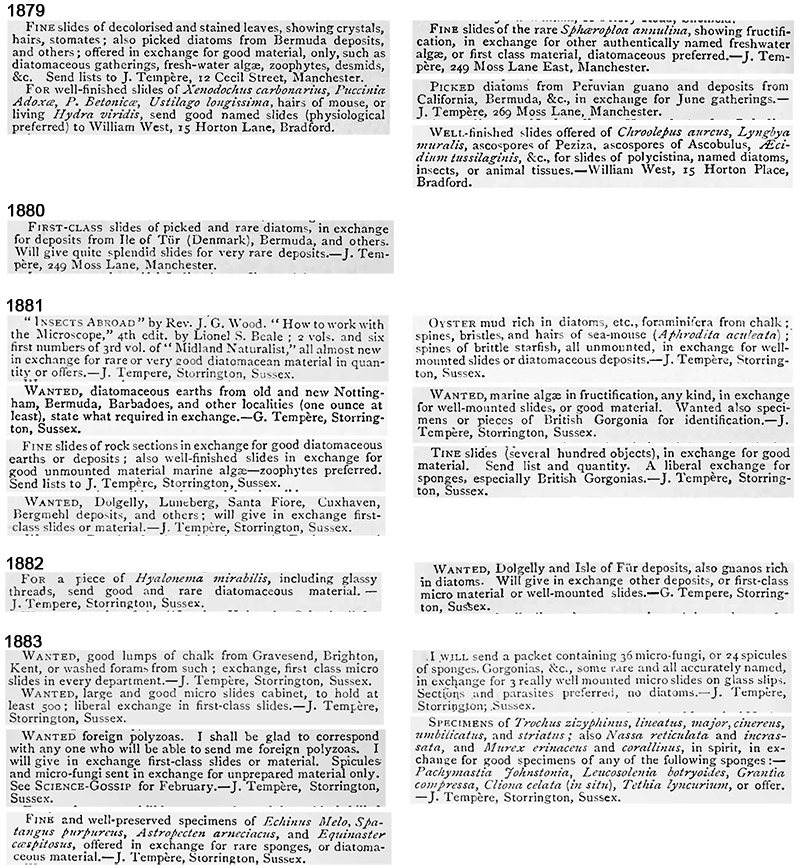
Figure 10.
Exchange ads by J. Tempère in which microscopical specimens or microscope slides were offered or sought, from “Hardwicke’s Science-Gossip”, 1879-1883. Also shown are two 1879 exchange ads from William West in which he offered microscope slides. It is notable that Tempère was requesting material from his Sussex address during 1883, at the same time as advertisements from “S. Louis” and William West were appearing (see Figure 12, below). This indicates that the business arrangement with West began at least half a year before Tempère left England.
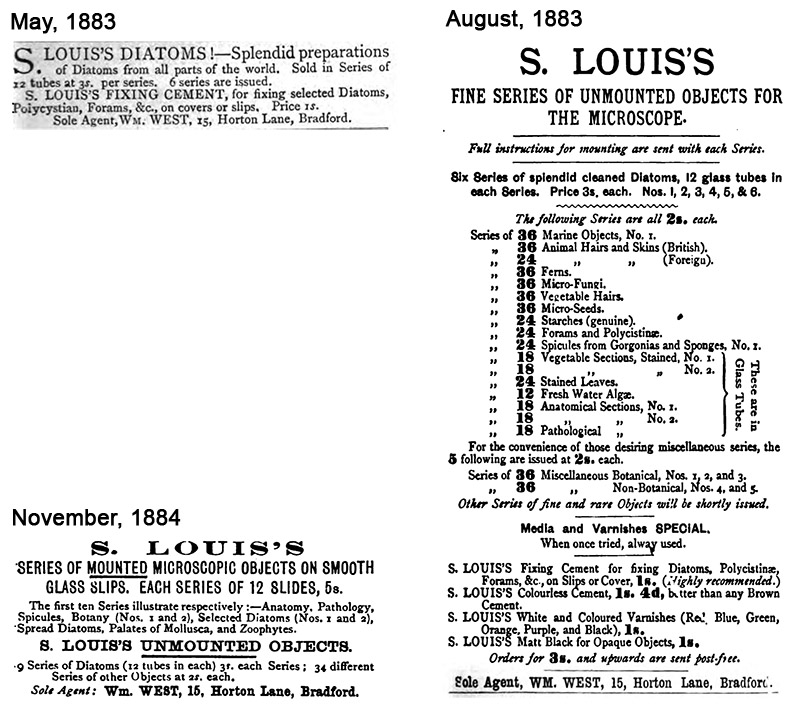
Figure 11.
Advertisements for microscopical preparations by “S. Louis”. The earliest known advertisement, from May, 1883, lists unmounted diatoms and “S. Louis’s Fixing Cement”. By that August, the inventory of unmounted preparations had grown considerably, as had also the variety of mounting cements. The earliest known evidence of S. Louis providing mounted slides was the advertisement from November, 1884. All ads are from “Hardwicke’s Science-Gossip”.
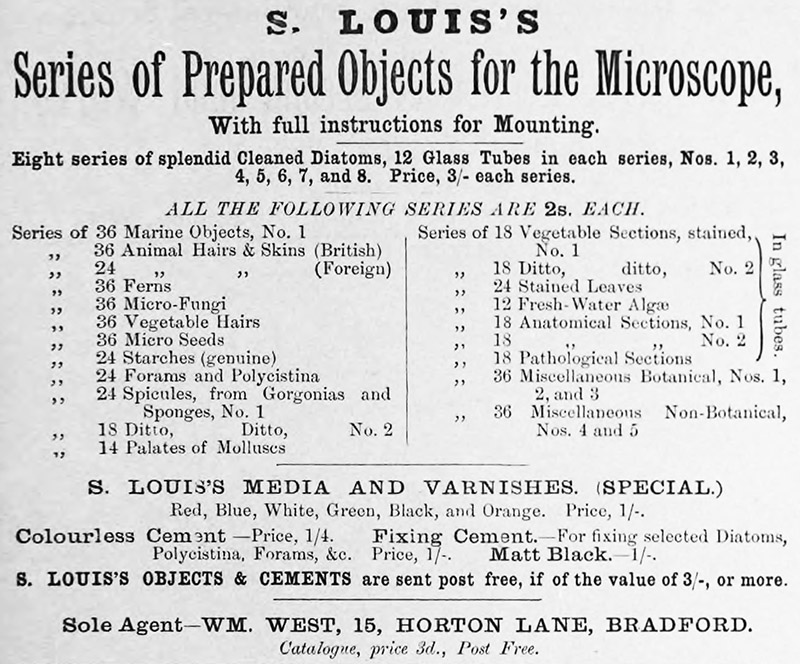
Figure 12.
An advertisement from an 1884 issue of “The Journal of Microscopy and Natural History”.
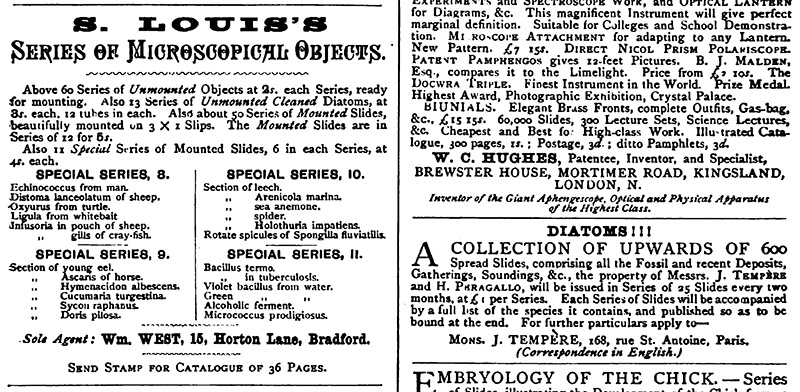
Figure 13.
Adjacent advertisements for Tempère’s two microscopical supply businesses. From an 1889 issue of “Hardwicke’s Science-Gossip”.
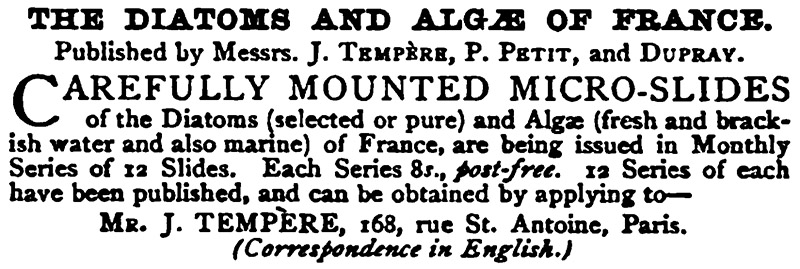
Figure 14.
1889 advertisement for the diatom slide series of Tempère and Petit, and the algae slide series of Tempère and Dupray. From “Hardwicke’s Science-Gossip”.
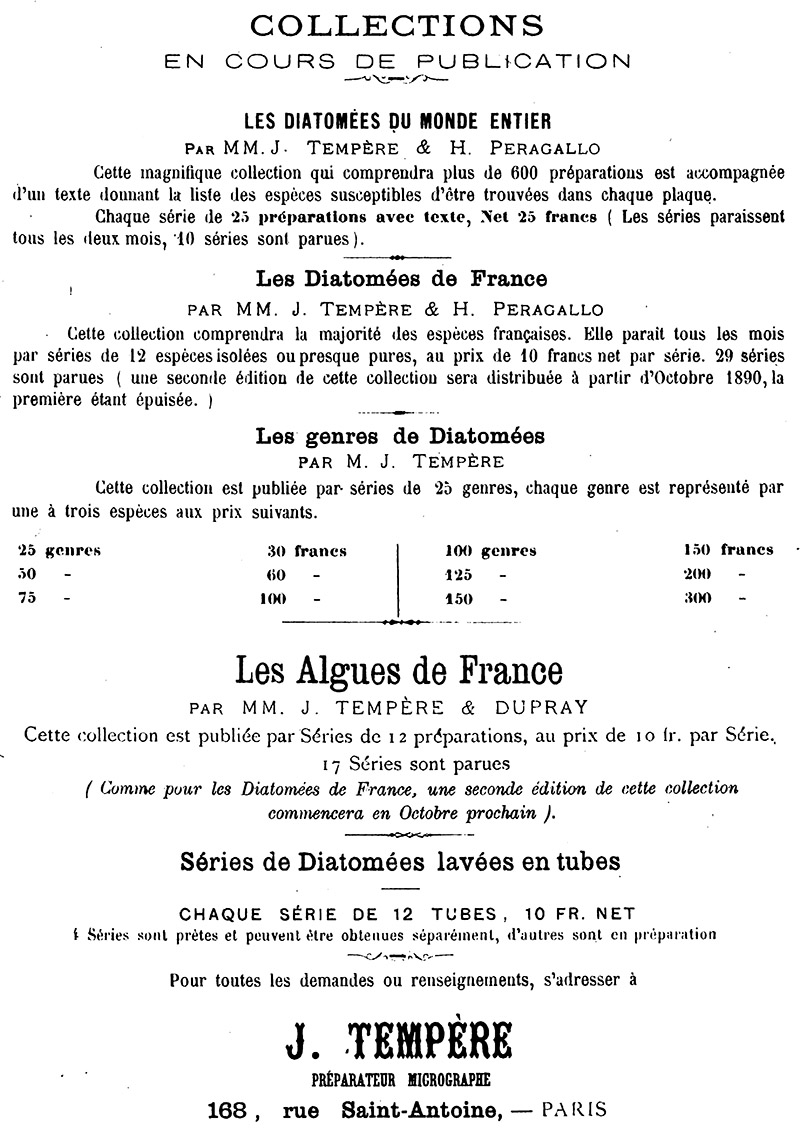
Figure 15.
An 1890 advertisement from “La Diatomiste”.
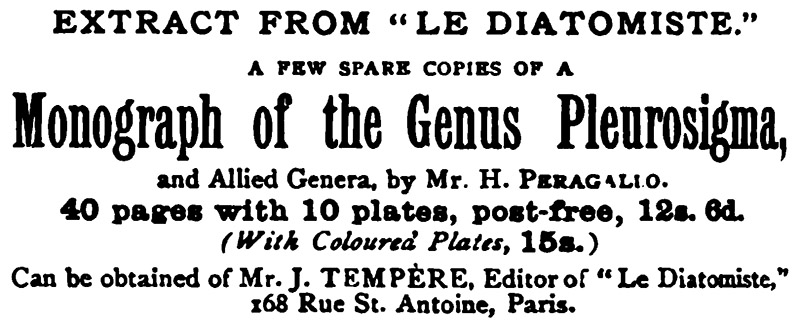
Figure 16.
An 1891 advertisement, from “Hardwicke’s Science-Gossip”.
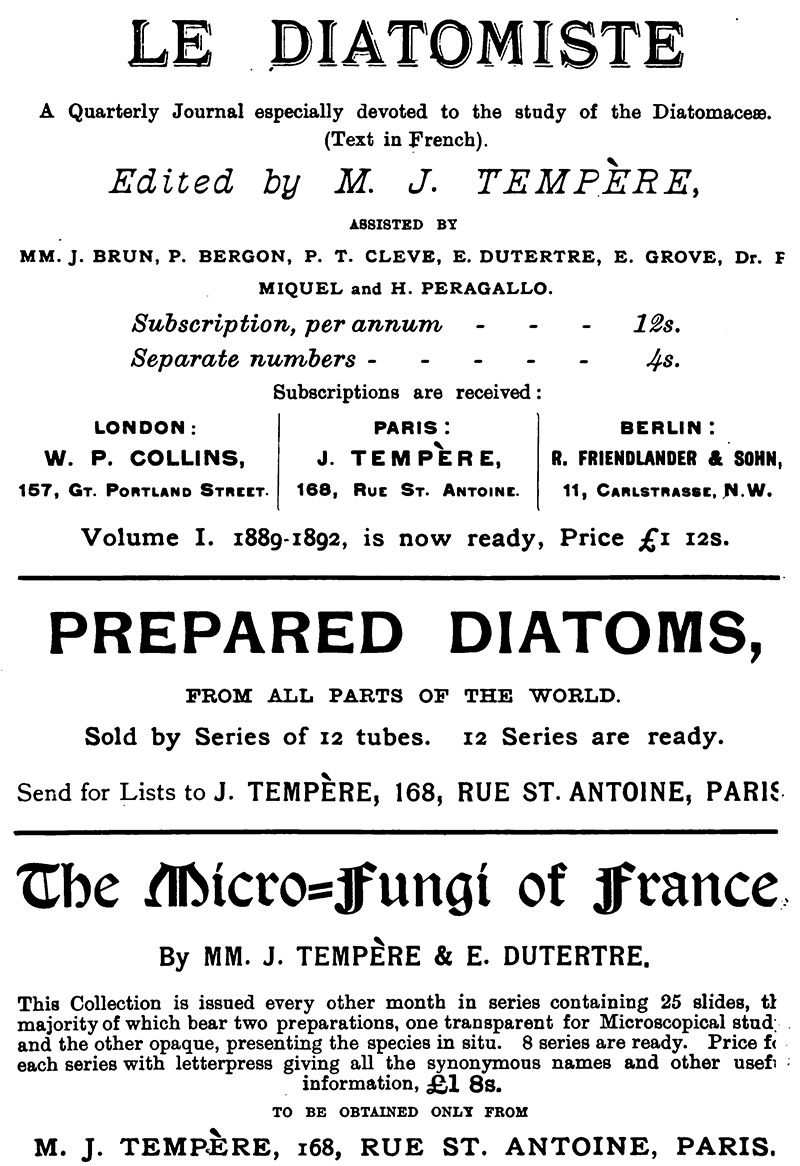
Figure 17.
Advertisements that were included in “An Introduction to the Study of the Diatomaceae”, by Frederick W. Mills and Julien Deby, 1893.
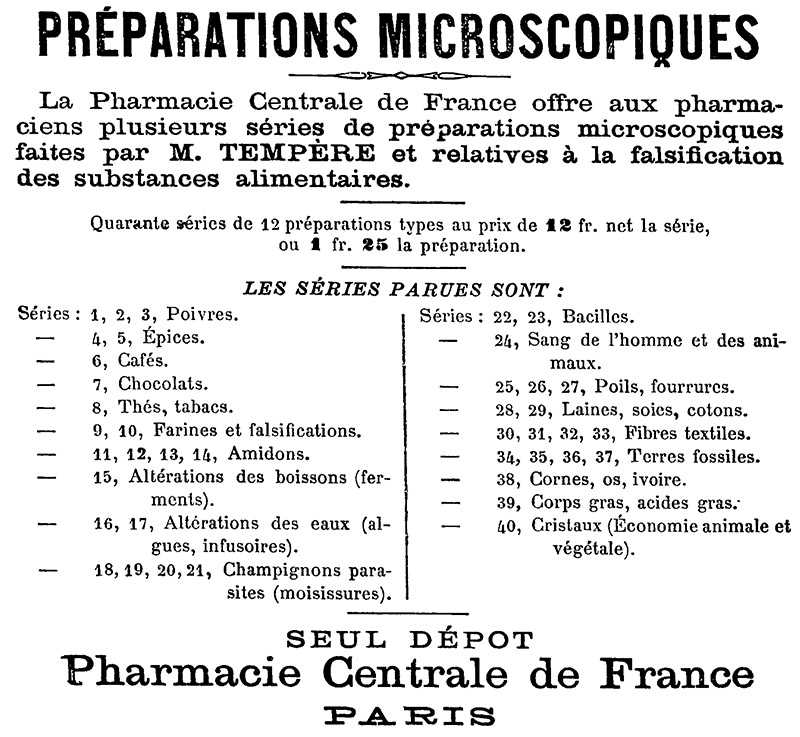
Figure 18.
Advertisement from “Bulletin Commercial”, 1895.
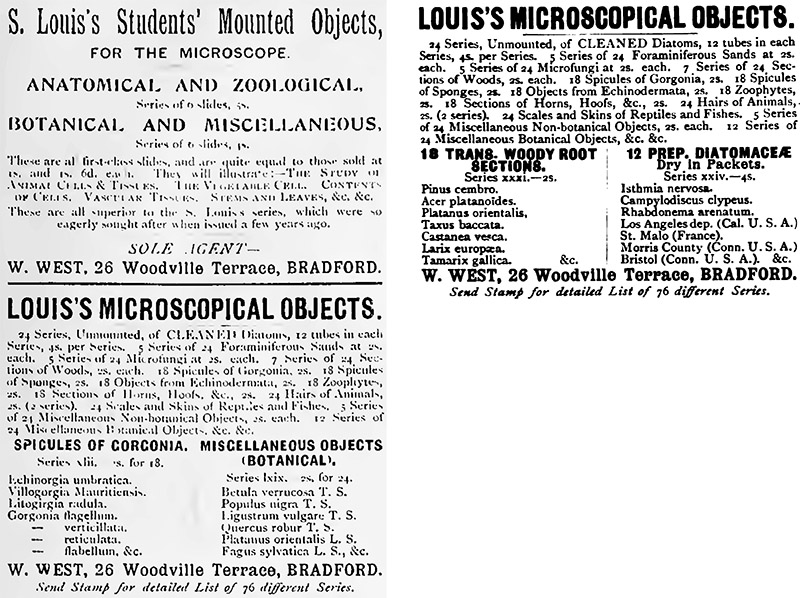
Figure 19.
Advertisements from 1900 (left) and 1901 (right), indicating that William West was still distributing “S. Louis” slides and unmounted material at the turn of the twentieth century.
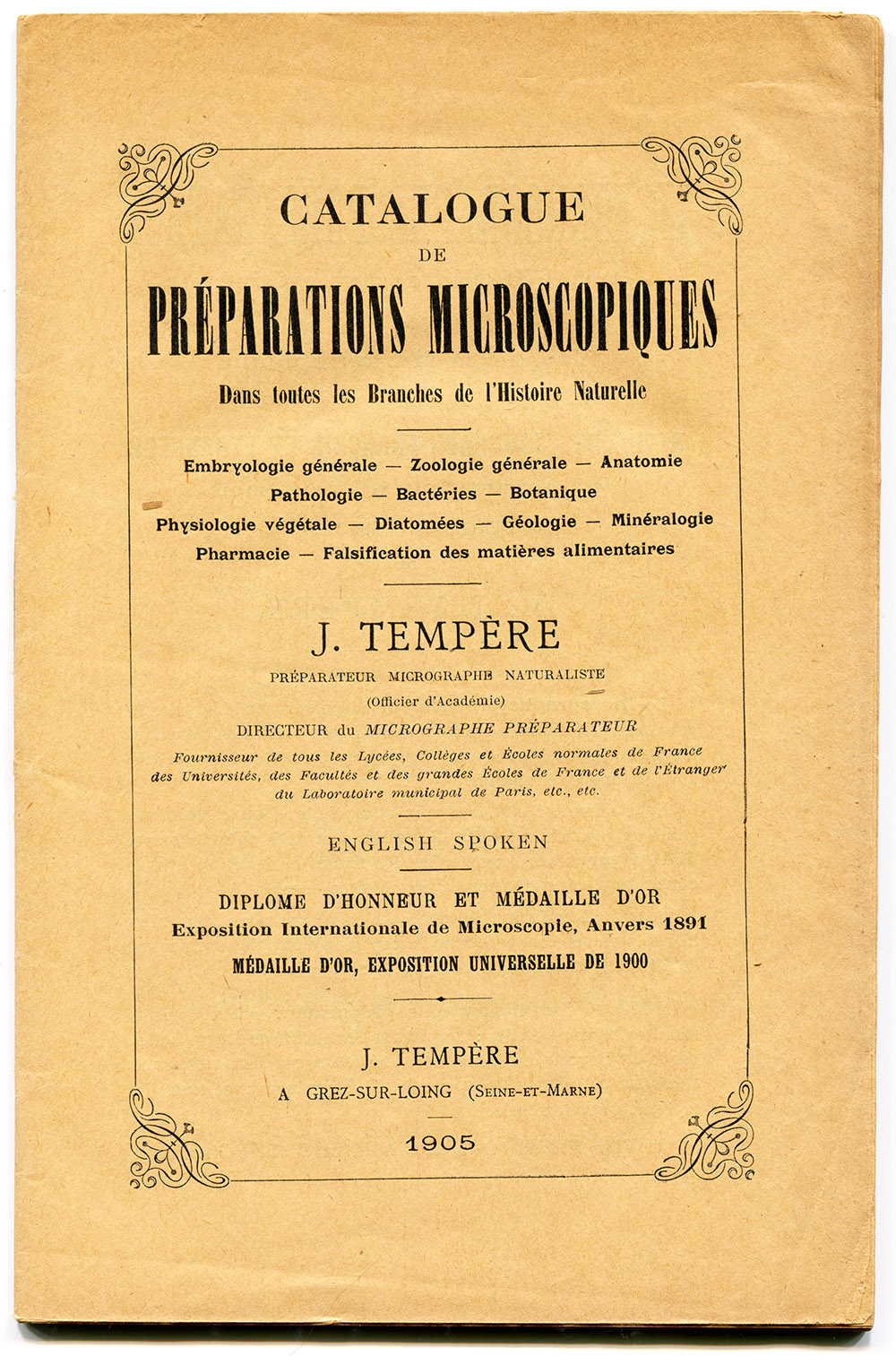
Figure 20.
Cover of Tempère's 1905 "Catalogue de Préparations Microscopiques"..
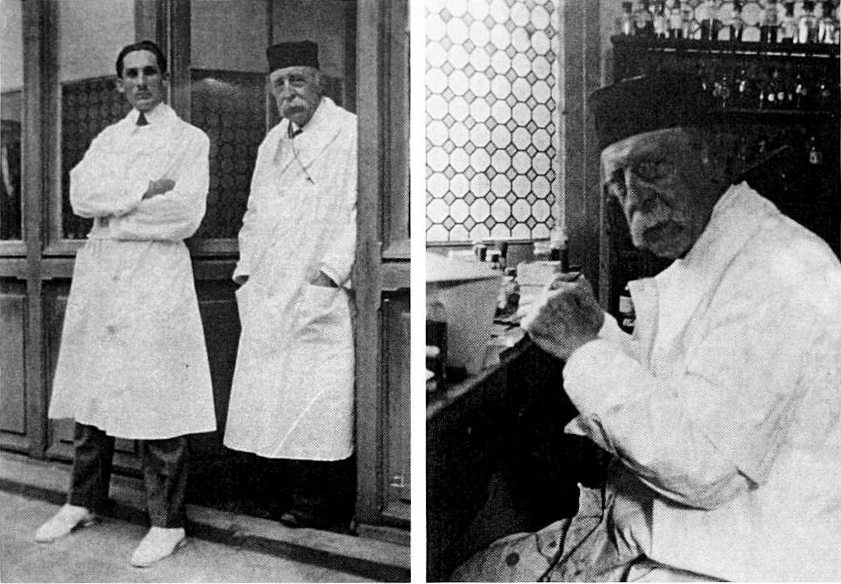
Figure 21.
Left, Jean Tempère with son Gaston in 1923. Right, Jean Tempère in his workshop, 1923. Both images adapted for nonprofit, educational purposes from Girodet, 1999.
Resources
Bracegirdle, Brian (1998) Microscopical Mounts and Mounters, Quekett Microscopical Club, London, pages 91-92 and 172, and plates 34-K, 34-L, 34-M, 34-N, 34-O, 34-P, 34-Q, and 34-R
Brun, Jacques, and J. Tempère (1889) Diatomées Fossiles du Japon, C. Schuchardt, Geneva
La Diatomiste (1890-1896)
The French Directory: Annuaire Commercial Et Industriel Guide Général (1882) “Professeurs de Langues … Tempere J., Storrington School Sussex”, page 364
Girodet, Pierre (1999) Famous mounters - Tempère, father and son, Quekett Journal of Microscopy, Vol. 38, pages 357-363
Girodet, Pierre (2004) Tempère’s artistic microscopic mounts, Quekett Journal of Microscopy, Vol. 39, pages 661-671
Hardwicke’s Science Gossip (1878) Response to and exchange offers from J. Tempère, Vol. 14, pages 72, 240, and 264
Hardwicke’s Science Gossip (1879) Exchange offers from J. Tempère, Vol. 15, pages 96, 144, and 284
Hardwicke’s Science Gossip (1879) Exchange offers from W. West, Vol. 15, pages 96, 192, 264, and 284
Hardwicke’s Science Gossip (1880) Exchange offers from J. Tempère, Vol. 16, pages 72 and 120
Hardwicke’s Science Gossip (1881) Exchange offers from J. Tempère, Vol. 17, pages 94, 144, 168, 192, 216, 240, and 284
Hardwicke’s Science Gossip (1882) Exchange offers from J. Tempère, Vol. 18, pages 48, 96, and 263
Hardwicke’s Science Gossip (1883) Exchange offers from J. Tempère, Vol. 19, pages 24, 48, 72, 240, and 264
Hardwicke’s Science Gossip (1884) Advertisements for S. Louis preparations, Vol. 20, advertiser sections
Hardwicke’s Science Gossip (1889) Advertisements for S. Louis and J. Tempère preparations, Vol. 25, advertiser sections
Hardwicke’s Science Gossip (1891) Advertisements from J. Tempère, Vol. 27, pages liv and lxx
Hardwicke’s Science Gossip (1892) “The Diatomist - We have received No. 10. of this quarterly specialistic work on Diatoms, edited by M. Tempere and other distinguished diatomists. As a rule and as far as possible each number is a monograph on some special and leading genus of diatoms. Hitherto each issue has been admirably illustrated, and the care taken in bringing out their illustrations as artistically as possible is shown by the fact that the present number, devoted almost entirely to the Entogonia, is not accompanied by the usual plates, the editors frankly stating that they did not turn out so well as they wished them to be, and they have therefore postponed their publication until the next number”, Vol. 28, page 260
Harvard University Herbaria & Libraries (accessed December, 2017) “Tempere, Johannes Albert & Petit, Paul Charles Michel, Diatomées de France (continued by Tempère & Peragallo): BM (r. 1893: 400 microscope-slides, 1887-1900)”, http://kiki.huh.harvard.edu/databases/botanist_search.php?mode=details&id=52384
Harvard University Herbaria & Libraries (accessed December, 2017) “Tempere, Johannes Albert & Peragallo, Hippolyte, Diatomées de monde entier, 1889-1914”, http://kiki.huh.harvard.edu/databases/botanist_search.php?mode=details&id=55095
Harvard University Herbaria & Libraries (accessed December, 2017) “Tempere, Johannes Albert & Dutertre, E., Champignons de France: BM (250 microscope-slides in 10 sets, 1892-93)”, http://kiki.huh.harvard.edu/databases/botanist_search.php?mode=details&id=55304
herbaria@home (accessed December, 2017) http://herbariaunited.org
The History of the Collections Contained in the Natural History Departments of the British Museum (1904) page 186
Journal de Micrographie (1889) Vol. 13, pages 524-525
The Journal of Microscopy and Natural Science (1884) Vol. 3, pages 66 and 196
Lallemand, Henri, and J. Tempère (1883) Practical French Grammar, Part 1, Hachette & Co., London
The London Catalogue of British Plants (1874) Seventh Edition, by R. Hardwicke, London
Marriage record of Jean Claudius Tempere and Scholastique Porchon (1897) August 8, accessed through ancestry.com
Le Micrographe Préparateur (1893-1906) Vols. 1-14
Mills, Frederick William, and Julien Deby (1893) An Introduction to the Study of the Diatomaceae, Iliffe and Son, London
The Northern Microscopist (1881) Exchange offer from J. Tempère, Vol. 7, page 228
Revue Scientifique (1882) “Tempère, membre de la Société de botanique de France, de Storrington (Sussex). - Sur un procédé de préparation pour l'étude des tissus végétaux”, page 191
Science Gossip (1900) Advertisements for S. Louis preparations, new series, Vol. 6
Science Gossip (1901) Advertisements for S. Louis preparations, new series, Vol. 7
Spence, D.S. (1957) From my notebook: Jean-Clodius Tempère, The Microscope, Vol. 11, page 125
Tempère, J. (1879) Plurality of petals in the genus Ranunculus, Hardwicke’s Science Gossip, Vol. 15, page 64
Tempère, J. (1881) Peridermium pini, Hardwicke’s Science Gossip, Vol. 17, page 140




















